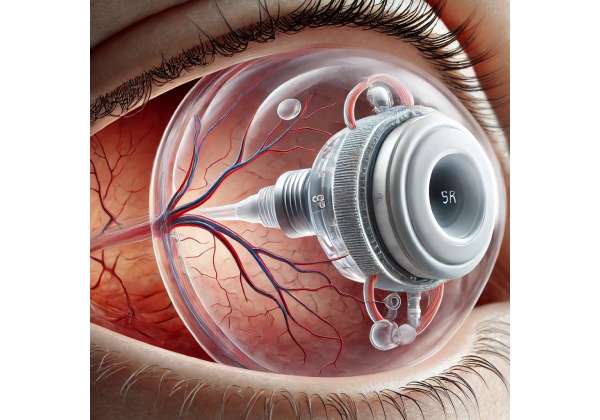Using CRISPR Gene Editing to Address Genetic Vision Loss in Best Disease
CRISPR gene editing is revolutionizing the way we approach genetic vision loss in Best disease by targeting the root cause of the condition. This breakthrough technology offers a promising alternative to traditional therapies, working at the molecular level to correct genetic mutations responsible for the degeneration of retinal cells. With its ability to modify DNA with unprecedented precision, CRISPR...
Upneeq for Acquired Blepharoptosis Lifting Eyelids with Advanced Oxymetazoline Ophthalmic Solution
Upneeq represents a breakthrough in the management of acquired blepharoptosis, offering a non-surgical solution that harnesses the power of advanced oxymetazoline to lift droopy eyelids. By stimulating the natural contraction of eyelid muscles, this innovative ophthalmic solution provides patients with a convenient, at-home treatment that enhances both appearance and visual function. Unlike traditional surgical interventions that carry risks and...
Tyrvaya for Dry Eye Disease Stimulating Natural Tear Production with New Varenicline Nasal Spray
Tyrvaya introduces an innovative approach to managing dry eye disease by harnessing the power of a new varenicline nasal spray that stimulates natural tear production. This breakthrough therapy works by activating neural pathways that promote tear secretion, offering patients an alternative to traditional artificial tear supplements and invasive procedures. By directly targeting the mechanisms responsible for tear regulation, Tyrvaya...
Treating Retinal Vein Occlusion Avastin’s Role in New Anti-VEGF Therapy
Avastin stands at the forefront of modern anti-VEGF treatments, offering a novel way to preserve vision in patients affected by retinal vein occlusion. By specifically targeting vascular endothelial growth factor, this therapy works to reduce macular edema and prevent further damage to the retina. Patients benefit from a treatment that is less invasive than traditional surgical methods and provides...
Treating Retinal Tumors with Transpupillary Thermotherapy A Safe and Effective Approach
Transpupillary Thermotherapy brings a new perspective to those seeking less invasive ways to address retinal tumors. Instead of relying on conventional surgical methods or systemic treatments, this heat-focused technique zeroes in on abnormal growths while aiming to preserve surrounding healthy eye tissue. By directing gentle yet precise thermal energy through the pupil, specialists can potentially halt tumor progression and...
Transpupillary Thermotherapy for Choroidal Neovascularization Targeted Heat Therapy for Retinal Conditions
Transpupillary Thermotherapy has captured the attention of eye care professionals by delivering targeted heat to specific parts of the retina. Rather than relying on broad-spectrum medications or more invasive approaches, this method uses controlled thermal energy to address abnormal blood vessel growth, known as choroidal neovascularization. Through careful application, clinicians aim to limit further deterioration and help sustain clearer...
Transcorneal Electrical Stimulation for Age-Related Macular Degeneration A New Approach to Vision Preservation
Transcorneal Electrical Stimulation is emerging as an innovative method that offers fresh hope to people striving to maintain visual health. By applying gentle electrical impulses directly to the eye, this therapy aims to enhance cellular activity and slow the progression of diseases that undermine clarity of sight. Unlike many traditional strategies, which can focus primarily on mitigating symptoms or...
Topical Ozone Therapy for Severe Dry Eye Disease Improving Eye Comfort
The push toward advanced therapies for persistent eye dryness has sparked growing interest in topical ozone applications. Instead of merely soothing symptoms, this approach focuses on rebalancing the ocular environment and supporting natural tear film stability. By delivering activated oxygen directly to the surface of the eye, topical ozone therapy aims to reduce irritation and promote healthy tissue dynamics...
Tocilizumab for Retinal Vasculitis Biologic Benefits in Vision Preservation
The arrival of Tocilizumab as a biologic therapy has sparked new optimism for those searching for advanced ways to protect their eyesight. Rather than relying solely on traditional anti-inflammatory medications, Tocilizumab offers a more precise approach by targeting the specific inflammatory processes that threaten retinal function. This approach not only aims to limit damage but also aspires to preserve...
Thymosin Beta 4 (Tβ4) The Cutting-Edge Peptide Transforming Corneal Healing and Dry Eye Treatment
Thymosin Beta 4, often abbreviated as Tβ4, is generating considerable excitement for its role in enhancing corneal healing and addressing persistent eye dryness. Beyond merely masking discomfort with artificial tears or topical drops, Tβ4 strengthens the fundamental regenerative processes that help repair damaged corneal tissues. This innovative peptide holds the potential to not only accelerate recovery from common eye...
Thymosin Alpha-1 (Tα1) Pioneering a New Era in Ocular Inflammation and Dry Eye Management
Thymosin Alpha-1 (Tα1) is rapidly gaining recognition as a novel approach to alleviating various forms of ocular irritation. Rather than simply offering fleeting symptom relief, this immunomodulatory peptide targets underlying inflammatory processes that can contribute to persistent dryness and discomfort. By engaging with the body’s immune mechanisms in a more balanced way, Tα1 opens new paths for sustaining healthier...
Therapeutic Hypothermia for Ocular Trauma How Cooling Therapy Helps Preserve Vision
Therapeutic hypothermia is rapidly emerging as a forward-thinking strategy to help safeguard visual function following serious eye injuries. Rather than simply masking the symptoms of damage, this cooling-based approach offers the potential for proactive tissue protection, leveraging precise temperature management to reduce inflammation and limit cellular harm. Healthcare providers are increasingly turning to targeted temperature reduction techniques in efforts to...
Tepezza for Thyroid Eye Disease Reducing Orbital Inflammation and Tissue Expansion with Cutting-Edge Therapy
Tepezza has emerged as a groundbreaking option for those seeking targeted relief from the effects of Thyroid Eye Disease. This advanced therapy addresses the inflammation and tissue expansion often associated with the condition, helping individuals find a path toward visual comfort, reduced orbital pressure, and improved quality of life. By focusing on a biologic approach rather than generalized treatments,...
Tear Osmolarity Reduction Devices for Dry Eye Disease Normalizing Tear Composition for Lasting Relief
Battling constant irritation, redness, and fluctuating vision can feel like a never-ending uphill climb when you have dry eye disease. Many people jump between lubricating drops, warm compresses, or nutritional supplements, hoping to find something that truly restores comfort. Among the newest and most forward-thinking approaches are tear osmolarity reduction devices, innovative technologies designed to stabilize the tear film...
Tarsus TP-03 An Innovative Treatment for Demodex Blepharitis
Finding effective remedies for persistent eyelid irritation can be a challenge, especially when standard interventions fail to tackle the root cause. Tarsus TP-03 steps into this gap as a cutting-edge therapeutic solution for Demodex blepharitis, a condition tied to the overpopulation of tiny mites on the eyelashes and eyelid margins. Rather than focusing on merely soothing symptoms, Tarsus TP-03...
Syfovre (Pegcetacoplan) FDA-Approved Solution Slowing Geographic Atrophy Progression in Late-Stage Dry Age-Related Macular Degeneration
Innovations in retinal therapies rarely arrive without great anticipation, and Syfovre (pegcetacoplan) is no exception. As the first FDA-approved treatment targeting geographic atrophy in late-stage dry age-related macular degeneration (AMD), this approach aims to slow the progression of a sight-threatening form of AMD for which effective interventions have long been scarce. By acting on a specific part of the...
Susvimo (Ranibizumab Injection) Revolutionizing Long-Term Anti-VEGF Therapy for Wet Age-Related Macular Degeneration
Long-standing reliance on frequent eye injections has prompted a search for more convenient and enduring anti-VEGF solutions. Susvimo, an advanced ranibizumab-based approach, is capturing attention for its potential to streamline care while delivering consistent therapy to those affected by neovascular or “wet” age-related macular degeneration (AMD). By introducing a refillable port delivery system, this treatment concept aims to keep...
Susvimo (Port Delivery System with Ranibizumab) A Game-Changer for Long-Term Diabetic Retinopathy and DME Treatment
The quest for better, more convenient therapies in the management of diabetic retinopathy and diabetic macular edema has entered an exciting new phase with the advent of Susvimo, an innovative implant for extended medication release. Designed to address the limitations of frequent eye injections, this approach strives to offer more consistent control over damaging blood vessel growth and fluid...
Supporting Retinal Health in Diabetic Retinopathy with Intraocular Oxygenation Devices
Innovative treatments continue to shape how medical teams approach diabetic retinopathy, aiming for more than just slowing the progression of disease-related complications. One promising option is intraocular oxygenation, a specialized method designed to enrich the eye’s internal environment with supplemental oxygen. Instead of exclusively relying on pharmaceutical interventions or laser procedures, intraocular oxygenation devices directly tackle a central issue...
Substance P An Innovative Breakthrough in Corneal Wound Healing and Dry Eye Relief
For many years, eye care professionals have relied on a limited range of treatments to manage corneal injuries and chronic dryness—chiefly artificial tears, lubricating ointments, and, in severe cases, corneal transplants or amniotic membrane therapy. However, as knowledge of ocular biochemistry expands, researchers have started pinpointing specific molecules in the body that can accelerate healing and support the natural...
Stem Cell-Derived Exosomes for Glaucoma Providing Neuroprotection in a New Form
Innovations in regenerative medicine continue to reshape how specialists approach and manage ocular health, and stem cell-derived exosomes are quickly becoming a focal point in this evolving landscape. While eye drops and surgical interventions have long dominated glaucoma care, the push toward biological treatments offers a glimpse into a more nuanced approach—one that emphasizes cell-to-cell communication and tissue rejuvenation....
Stem Cell Therapy Cutting-Edge Cell Replacement Therapy for Both Wet and Dry Age-Related Macular Degeneration
New breakthroughs in cellular science are transforming the landscape of vision care, and stem cell therapy stands out as one of the most promising solutions for a range of eye disorders. By introducing healthy, lab-grown cells to areas of tissue damage, scientists and clinicians are seeking to pioneer a technique that goes beyond halting disease progression—it aims to replenish...
ST266 for Optic Neuropathy Nasal Neurostimulation Therapy Supporting Nerve Recovery with Modern Technology
Innovation in regenerative medicine is changing the landscape of ocular health, and ST266 stands out as one of the promising developments specifically tailored for individuals managing optic neuropathy. While traditional therapies have aimed to halt or slow the progression of nerve damage, ST266 nasal neurostimulation therapy introduces a groundbreaking approach intended to promote nerve recovery and visual function. This...
ST266 for Dry Eye Disease Delivering Neuroprotective Proteins to the Eye with Innovative Nasal Spray
Eye therapies are evolving beyond conventional drops and ointments, with a growing emphasis on treatments that promote deeper, more sustainable relief. One such innovation is ST266, a solution containing neuroprotective proteins that can reach the eye via a nasal spray rather than direct ocular application. This approach offers a fresh angle on managing Dry Eye Disease—potentially helping patients who...
Speeding Corneal Healing with Molecular Hydrogen What You Need to Know
Innovation in ocular treatments continues to offer new possibilities for faster recovery and enhanced comfort. One emerging method is the use of molecular hydrogen, a naturally occurring gas that may speed up corneal healing. Rather than working as a broad-spectrum antioxidant, molecular hydrogen selectively targets the most harmful reactive oxygen species in the body, potentially reducing tissue damage and...
Smart Contact Lenses for Glaucoma How Nanotechnology is Revolutionizing Eye Care
Innovations in eye care often appear at the intersection of technology and medical science, and few advancements embody that quite like smart contact lenses for glaucoma. Rather than manually measuring eye pressure at a clinician’s office, these nanotechnology-powered lenses are designed to gather real-time data and deliver medication precisely when and where it is needed. By integrating sensors and...
Slowing Down Retinitis Pigmentosa The Power of Molecular Hydrogen Therapy
Harnessing the power of molecular hydrogen is an innovative way researchers and clinicians are now approaching complex vision challenges. Rather than relying solely on traditional therapies, scientists have begun exploring how hydrogen’s antioxidant potential might help preserve sight in individuals facing progressive conditions like Retinitis Pigmentosa. This approach taps into hydrogen’s unique ability to selectively neutralize harmful free radicals,...
Scleral Lens Fitting for Severe Dry Eye and Ocular Surface Disease Enhancing Eye Comfort
Advances in eye care have shifted the conversation from simply managing symptoms to actively improving comfort and stabilizing the ocular surface. One innovation that stands out is the use of scleral lenses. For individuals living with severe dry eye and ocular surface disease, these specialized lenses can make a noticeable difference in day-to-day quality of life. Rather than coping...
Scleral Cross-Linking A New Approach to Managing Progressive Myopia
Innovation in vision care has shifted dramatically toward treatments that address the root causes of refractive changes, rather than simply correcting them on the surface. Scleral Cross-Linking is one such breakthrough that aims to stabilize progressive myopia by reinforcing the eye’s outer layers. Instead of relying on eyewear or daily interventions that only refocus incoming light, this technique targets...
Scleral Contact Lenses for Keratoconus A Vision Improvement Solution
When it comes to cutting-edge solutions for complex eye conditions, few innovations are as exciting as scleral contact lenses. Instead of accepting the limitations of traditional lenses, people with challenging corneal shapes now have an option designed specifically to maximize comfort, clarity, and stability. These specialized lenses vault over irregular corneas, resting gently on the sclera (the white part...








































